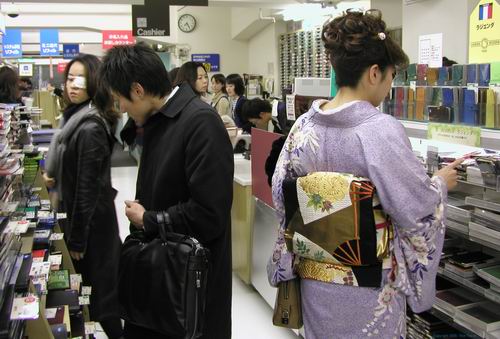I imagine you haven't thought of Japanese kimonos and eye patches at the same time before. There is a connection however, in that both the impractical but beautiful kimono, and the practical but ugly eye patch are less and less in evidence in 21st century Japan. Eye patches were much in evidence in the eighties, but usage has dropped off for whatever reason.
Questions - why were the eye patches used in the first place and why has the usage been discontinued? Who knows! Who cares! The best way to get along in Japan is not to ask questions unless you absolutely have to, and no sooner would you ask an eye patch wearer why they're wearing a patch than you would ask a tree why it has leaves of an unusual shape.

The reason I and the others were in Itoya in Ginza... (I must protest against the usage of the term "The Ginza" by the way - Ginza is, after all, an area name, like Aoyama, Shibuya, Shinjuku, Marunouchi, etc. Ginza is a nice area to be sure, but it doesn't need "The"). I was there to shop at Itoya - probably the best-known store in Tokyo to buy schedulers (organizers, planers, whatever - the paper kind), with both local and imported versions. Older men come in looking for a type they've used for decades which are becoming harder to find; women come in to get fashionably exotic imported ones from France and Italy, and yours truly comes in to get the same type he's been using for over ten years now - one of the few compact ones with maps of the world at the back.
The moment I realized the importance of schedulers is still etched sharply in mind:
1984 - I was standing on a street in Shinjuku talking with a J-friend and we agreed to meet up in three weeks' time. Schedulers were taken out and the date and time duly noted. After I had written the time and date in my own scheduler, I said, "Okay - I'll call you a couple of days beforehand to make sure the time is still okay."
My friend then said that no such call was necessary. Surprised to hear that, I raised my eyebrows and said, "Even after three weeks?!?" and I can still see the expression on her face ("Must be patient with foreigners - they don't honor time as much as we do...") as she reassured me that no confirmation would be needed and that she would see me in three weeks at precisely the agreed-upon time.
I was skeptical, but I went to the agreed-upon place (this was before cell phones after all) three weeks later, and there she was - like clockwork. After seeing that people always kept their appointments, I came to place some trust in schedules. Once it's in the scheduler, it's very rarely changed and, if it is, there is ample advance warning given with profuse apologies.
I bring all this up to shed some light on the importance of people's schedulers, which also double as address books and desk references. Buying a new scheduler is as much an end-of-year rite as Christmas shopping and getting ready for the biggest holiday of the year - New Year's.
Copyright 2003 - Lyle (Hiroshi) Saxon, Images Through Glass, Tokyo